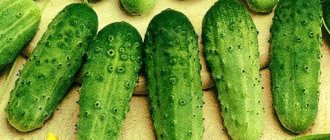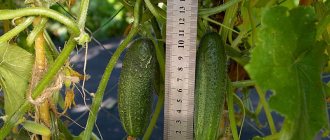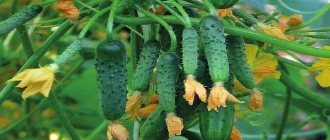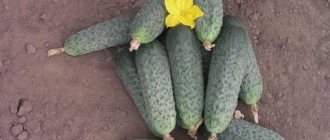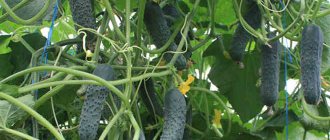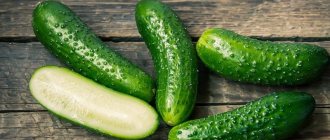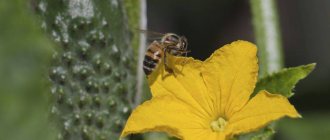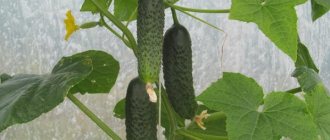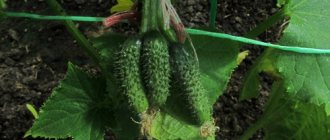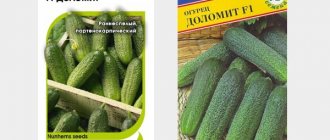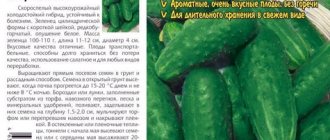It is worth starting the description of the Arctic cucumber variety with its characteristic features. Arctic f1 cucumbers are a fairly new, practically unknown hybrid variety bred in Korea. Most experienced gardeners consider this variety to be promising and quite productive. Another name for the variety is Arena f1 cucumbers. Next to the name there is a postscript f1, indicating that the cucumbers belong to hybrid varieties. Let's look at a detailed description of cucumbers.
Description of Arctic cucumbers
Arctic f1 cucumbers are the result of breeders from the Korean company NongWoo Bio. The variety is classified as parthenocrapic varieties. The new variation of cucumbers has not been recorded in the State Register of the Russian Federation, but has already attracted the attention of not only experienced gardeners, but also farmers involved in growing vegetables on an industrial scale.
Arctic cucumbers are grown both in open and closed ground, so their planting is preferred in many regions of the Russian Federation.
In terms of ripening time, the Arctic f1 variety belongs to the ultra-early varieties, since the first harvest is harvested 32-40 days after planting.
Description of cucumbers Arctic f1:
- It is an indeterminate plant because it does not require pinching; The bushes grow up to 2 m, are covered with small thorns, small internodes and have quite a lot of leaves;
- Description of the leaves: five-lobed, heart-shaped, have a bright green color and slight pubescence, on their surface there is a waxy coating that protects against various pests and cold weather;
- Description of flowers: flowers of the Arctic variety are bright yellow in color, located in the axil of the leaves and belong to the female inflorescences;
- The fruits are cylindrical, up to 12 cm long;
- The skin of the fruit is bright green and has small black spines;
- Description of the pulp: juicy, tender, has no voids;
- Description of taste: sweet, not bitter.
It should be noted that Arctic f1 cucumbers are distinguished by their high yield. High fruiting is caused by the fact that the male nodes on the bushes are located quite close to each other. About 3 flowers are formed in all internodes, followed by greens.
A distinctive feature of the Arctic f1 variety is its ability to regenerate, since they can re-form ovaries at the bottom of the stem.
In addition, cucumbers are self-pollinating and resistant to most cucumber diseases and pests. However, the variety does not tolerate dry weather: it needs systematic watering, and excessive overheating or waterlogging leads to the death of the plant’s roots.
Arctic f1 cucumbers tolerate changes in atmospheric pressure, in particular cold snaps. Cucumbers are characterized by high shelf life and transportability. The fruits of the plant are used not only for fresh consumption, but also for preparing salads, as well as for pickling or seaming.
Advantages and disadvantages
Relative disadvantages include the presence of a thick peel, as well as the inability to collect the seeds yourself.
The main advantages of the hybrid include:
- Excellent taste characteristics;
- Resistance to temperature changes;
- Early ripening;
- Good keeping quality and transportability;
- Possibility of regeneration, i.e. repeated fruiting;
- Universal use of fruits;
- Immunity to viral and fungal diseases;
- Long-term fruiting;
- High yield;
- Excellent commercial quality;
- Self-pollinating;
- Friendly and quick yield of the harvest;
- High germination rate (95-98%).
Pros and cons of the variety
The first to appreciate the Arctic f1 cucumber variety were Russian farmers and gardeners. According to their reviews, cucumbers are quite promising and have a number of positive characteristics. However, even a seemingly ideal variety has a number of shortcomings, indicating that breeders have work to do.
pros
- Excellent productivity;
- Fruiting is long;
- Early fruiting;
- Universal use of cucumbers;
- The plant's ability to regenerate;
- Excellent immunity to many cucumber diseases and pests;
- Excellent keeping quality;
- Growing in open and closed soil;
- Formation of small internodes;
- Excellent transportability;
- Resistant to temperature changes.
Minuses
- Lack of seeds for next plantings;
- Requirement for moisture;
- The need for supports;
- The need for systematic treatment of bushes from pests;
- Quite thick skin of the fruit.
Characteristics
- Korean Arctic is an early ripening hybrid. The period from the emergence of seedlings to the start of fruiting is a record 33 days; in the most unfavorable conditions, this period can stretch up to 42 days. This early ripeness allows the crop to be used in extended rotation, making it profitable for industrial cultivation;
- The cucumber yield is very good due to short internodes and bunched fruiting. In addition, the overall indicator is increased by good plant regeneration, which is not inherent in all varieties. It lies in the fact that after the first wave of fruiting, despite the fact that the greens are still ripening in the upper part of the bush, the process of re-formation of the ovaries begins in the lower part. High yields have become another parameter due to which our hero is popular in industrial cultivation;
- The hybrid's immunity is very good. High resistance to common crop diseases - fusarium, tobacco mosaic virus, downy mildew. Resistance to pests is also noted - whitefly, spider mites, aphids;
- The Arctic is resistant to temperature changes, especially cold snaps;
- self-pollination is another plus, allowing the cucumber to set and form a crop on its own, which is especially valued in closed greenhouses;
- The transportability of the variety is at a high level; the presentation of the cucumbers will not be affected even after long-term transportation. Keeping quality is good;
- The method of use is universal. The early harvest is most often used in its natural form, but the fruits have shown excellent pickling qualities and suitability for canning.
Landing Features
To get a good harvest, you must follow all the rules for planting and caring for the Arctic f1 cucumber variety. Arctic cucumbers are planted using both sowing and seedling methods.
Landing dates
Planting Arctic cucumbers depends on the climate where the vegetables will be grown. As a rule, seedlings are planted in the second half of May, when the ground temperature reaches 15 degrees Celsius.
If cucumbers are planted by seeds, planting is carried out at the end of April. It is recommended to plant planting material without covering cucumbers with film in mid-June.
Site preparation
To plant Arctic f1 cucumbers, choose a place that is sufficiently sunny and, at the same time, sheltered from the winds. It is not recommended to plant cucumbers in pits and lowlands, where water stagnation is usually observed.
Before planting Arctic cucumbers, they dig up the soil and saturate it with minerals: fertilize it with compost, peat, manure, or bird droppings.
Experts recommend paying attention to the predecessors of the variety. Arctic cucumbers grow well after legumes and grain crops. Low survival rate of the variety is observed on land where tomatoes, potatoes, and pumpkins were previously grown.
Planting seeds
If the Arctic cucumber variety is planted by direct sowing, the seeds are placed in a damp cloth and sent to a cold place for 24 hours. A day later, the planting material is treated with a manganese solution and planted to a depth of 2 cm. Afterwards, the seeds are covered with a thick film until the sprouts emerge.
Planting seedlings
As a rule, cucumbers are planted in seedlings. To obtain seedlings, Arctic f1 cucumber seeds are placed in peat-covered cups so that the plant can be replanted with them in the future.
The seeds are placed in the soil at a depth of 2 cm. After the sprouts appear, they are transplanted into open ground.
It should be noted that Arctic seedlings, like Crispin cucumber seedlings, are recommended to be planted before they reach large sizes, since the yield level is reduced.
Planting scheme
If Arctic cucumbers are planted in a greenhouse, the beds are arranged in a checkerboard pattern. The distance between the beds is 60 cm, that is, about 4 seedlings fit in 1 m2.
If cucumbers are planted in open soil, it is necessary to make beds whose height will reach 30 cm and width - 80 cm. On the day of planting the planting material, it is necessary to dig holes, the distance between which will reach 60 cm. The depth of the holes depends on the height of the pot in which seedlings are located.
Where to buy Arena F1, cucumber (Arctic) (500 seeds)?
Close proximity to groundwater is undesirable, since it has a detrimental effect on the root system.
To avoid all these manipulations, you can purchase seed material in a specialized store.
Disembarkation:
- Planting holes are placed at intervals of 60 cm, in a checkerboard pattern;
- The depth of the holes is made in accordance with the height of the pots with seedlings;
- Approximately 4 cucumber seedlings are placed per 1 m2;
- The soil near the bushes is mulched down to the cotyledon leaves, using peat or sawdust.
Manufacturer
NONG WOO Bio (Korea)
Arena F1 is an early parthenocarpic hybrid of gherkin-type cucumbers, characterized by high yield, uniformity of fruits and attractive appearance. Perfect for growing both in greenhouses and in open ground.
Plant
- growing season 33-40 days
- very powerful
- abundantly covered with leaves
- internodes are short
- 2-3 greens in each bosom
Fruit
- regular cylindrical shape
- thick glossy peel
- often tuberous
- length 10-11 cm
- diameter 3-3.5 cm
Arena F1 cucumbers are grown in both spring-summer and summer-autumn rotations.
Also in our store there are 38 more products from the “Cucumber” category that may interest you
We offer to buy in our online store Arena F1, cucumber (Arctic) (500 seeds) from NONG WOO Bio (Korea) with delivery. You can pay for the goods by credit card through the website, or upon receipt by card or cash. We carry out delivery through transport companies or Russian Post (read more in the “Payment and Delivery” section). There is a flexible system of discounts, please call the toll-free number for details.
- Quality guarantees. You are guaranteed to purchase an official product and actually first-hand with all certificates and permits.
- Prices from the manufacturer. You purchase goods without intermediaries, which means there are no additional markups from resellers.
- Trained staff. Manufacturer representatives regularly visit us and talk about advanced technologies and new products in their field.
- Wide range of products. We can supply any product that is in the assortment of a given manufacturer in a fairly short period of time.
Care
Arctic cucumbers f1 are demanding in care. The variety needs systematic watering, plant feeding and spraying against pests.
Watering
It is recommended to water cucumber bushes in the early morning or late evening. The water temperature should match the soil temperature. As a rule, water is heated in the sun or slightly heated over a fire.
It is recommended to water the plants every other day, and during the period when the fruits appear, the bushes must be watered every day.
Garter and bush formation
The Arctic cucumber variety does not require pinching. However, the fruits of the plants need to be tied to a trellis. The recommended height of the trellis is at least 2 m.
Top dressing
To get a large amount of harvest, it is recommended to feed Arctic cucumbers with fertilizer. As a rule, fertilizing is carried out according to the leaves. Spray the plants with complex fertilizers combined with potassium humate. It is recommended to fertilize in the first half of the day. For the second feeding, potassium nitrate is used.
Hilling
It is not recommended to hill up the ground where cucumbers grow, since their root system spreads quite close to the earth's surface. Thus, when hilling, there is a risk of damaging the roots of plants, which will lead to their death.
However, experts recommend loosening the soil with a pitchfork. This method allows you not only to pass oxygen to the roots of cucumbers, but also to get rid of unwanted plants.
Agricultural technology
It is recommended to grow the Arctic by seedlings or sowing seeds directly into the ground in greenhouses. In heated greenhouses, you can get a harvest of cucumbers as early as April; for this, seeds are planted for seedlings in the second ten days of February. The seedlings are transplanted after approximately 21 days. Bushes of this variety must be tied to a trellis and formed into 1 stem. The crop is demanding on watering and timely fertilizing; without this, good fruiting cannot be achieved. It is especially important to feed the plant during the period of intense fruit production. Mineral complexes can be used as fertilizer - nitrogen complexes at the time of growth, phosphorus-potassium complexes during the period of crop formation. Organic will do. Types of fertilizing can be alternated. Due to its good cold resistance and excellent disease resistance, the variety is successfully grown in the second rotation. Even though the temperature drops during this period, the plants still need to be well watered and fertilized.
The Arctic hybrid is not yet very well known among ordinary vegetable growers, but in industrial cultivation it is used with great success due to its rare ability to regenerate, and therefore high productivity. The variety has proven itself not only in protected soil, but also shows decent results in open soil. Good immunity of the variety allows you to reduce the number of chemical treatments and obtain an environmentally friendly product. No shortcomings were identified during cultivation. The disadvantage is the need to tie up and shape the plant, and the big disadvantage is the inability to independently collect cucumber seeds.
It is difficult to find any variety of garden plant with impeccable characteristics. The Arctic F1 cucumber is close to perfection, as it satisfies everyone, even the most demanding tastes. The characteristics of cucumber allow it to be grown in different regions and climatic conditions.
Diseases and parasites
The creators of the hybrid variety of cucumbers Arctic worked on the strong immunity of cucumbers and endowed them with the ability to tolerate the most popular diseases of cucumbers: brown spot, powdery mildew, tobacco mosaic, ascoditosis, and cladosporiosis.
In addition, Arctic f1 cucumbers are not susceptible to pests such as whiteflies, aphids, or spider mites.
However, if cucumbers are not taken care of and preventive spraying is not carried out in a timely manner, the plant may encounter these diseases. It is recommended to spray the bushes with Topaz solution, Bordeaux mixture or Fitosporin.
Harvesting and storage
The fruits are harvested 32-40 days after planting the cucumbers. Due to the high fruiting of the variety, it is recommended to pick the fruits immediately after they appear. The next cucumbers appear within 1-2 days.
It is recommended to store cucumbers in a cool place. If they will be used in the coming days, they are stored in the refrigerator. If Arctic cucumbers are left for long-term storage, it is better to use a cellar.
